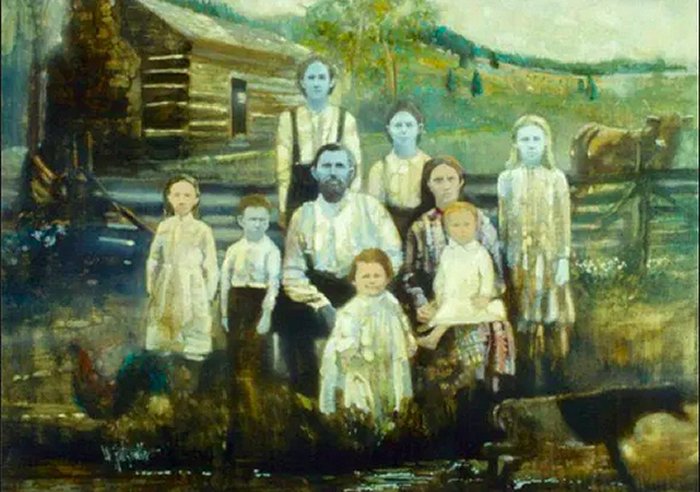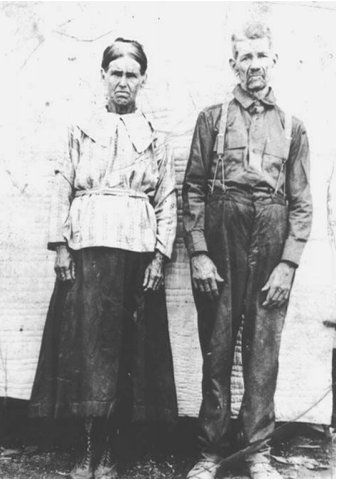Ellen Lloyd – AncientPages.com – People with blue skin can exist and are not a myth.
The Blue Fugates, often referred to as the Blue People of Kentucky, have long been of scientific interest. Why was their skin blue? There is a scientific explanation behind this unusual genetic condition.

– https://facts.net/the-fugate-family/ via Wikipedia
When the Fugate clan was first spotted, they startled people. The year was 1822, and Martin Fugate, an orphan from France, had just come to the Troublesome Creek region to start a family. Whether he had blue skin or not is uncertain as the reports vary, but it is assumed that he was blue.
An Unfortunate Coincidence – People With The Same Rare Genetic Trait Married
Martin settled in the area and married Elizabeth Smith, who was pale and had red hair. They had seven children, and four of them had blue skin. Martin and Elizabeth lived in a very isolated area, and newcomers were rarely seen there. Elizabeth was closely related to a nearby clan and may have also had some genetic abnormalities.
It led to a high level of consanguinity in marriage between families. Consanguinity, a relationship by descent from a common ancestor, can cause significant genetic disease.
At the time, Martin Fugate did not know that he had married a woman with the same rare genetic trait he had. It was an unfortunate coincidence.
The disease gene continued to spread when Zachary, one of Martin and Elizabeth’s blue sons, married Elizabeth’s sister.
Zachary had many children. Levy, one of his sons, married a woman from the Ritchie clan, another prominent family in the region. Together, they had eight children, including Luna, born with nearly purple skin!
Since members of the Fugates married cousins and close relatives, the blue-skinned disorder continued to thrive.
Difficult Life For The Blue People Of Kentucky
Life for the Blue people of Kentucky was not a dance on roses. All Blue Fugates were stigmatized due to their unusual appearance. Neighbors laughed at the family’s blue coloring, and most avoided the Fugates. Shame, psychological trauma, and discrimination resulted in the Blue People of Kentucky isolating themselves from the rest of society.

Lorenzo, “Blue Anze” and Eleanor Fugate, circa 1915. Lorenzo was a son of Zach Fugate. Credit: Mary Fugate.
When a new baby was born, the blue color faded soon after birth, but adults often had to face lifelong suffering, being blue-skinned and different from all other human beings.
The poor Blue people of Kentucky had no idea why their skin had this unusual color, so they just tried to live everyday life. What else was there they could do?
Blue-skinned people continued living in Troublesome Creek and Ball Creek areas into the 20th century. Then, sometime in the sixties, something finally happened, and this unusual medical condition was investigated.
One day, Dr. Madison Cawein learned about some blue-skinned people who lived in Troublesome Creek. Eager to learn more about the Blue Fugates, he recruited a nurse called Ruth Pendergrᴀss to help him in his investigations.
Ruth Pendergrᴀss was interested because she had previously met a dark blue woman at the clinic. The blue woman had come to ask for a blood test, and her extraordinary appearance terrified Pendergrᴀss.
“She had been out in the cold, and she was just blue! Her face and her fingernails were almost indigo blue. It used to scared me to death! She looked like she was having a heart attack. I just knew that patient was going to die right there in the health department, but she wasn’t at all alarmed. She told me that her family was the blue Combses who lived up on Ball Creek. She was a sister to one of the Fugate women, “Pendergrᴀss recalled.
Proper medical examinations conducted by Dr. Cawein and nurse Pendergrᴀss revealed the truth about the Blue People of Kentucky. They suffered from a disease known as methemoglobinemia.
When methemoglobin levels in the red blood cell are above one percent, skin turns blue, lips become purple, and normal red blood is chocolate brown. This disease can be inherited or triggered by exposure to chemicals like benzocaine and xylocaine.
The good news for the Blue People of Kentucky was that they were cured! Dr. Cawein prescribed them daily methylene blue tablets, and the blue skin color vanished. After suffering humiliation for generations, they could finally enjoy a normal life without being ridiculed.
Born in 1975, Benjamin Stacy is the last known descendant of the Fugates. He also had blue skin, but the color vanished as he grew older.
So, no, people with blue skin are not a myth. They are not often encountered, but they can be confirmed.
Written by Ellen Lloyd – AncientPages.com Staff Writer
Updated on September 17, 2023
Copyright © AncientPages.com. All rights reserved. This material may not be published, broadcast, rewritten or redistributed in whole or part without the express written permission of AncientPages.com
Expand for references
Cathy Trost – The Blue People Of Troublesome Creek
Rosie McCall – The Science Behind The Mysterious Blue People Of Kentucky
Celeste A. Leander, Robert J. Huskey – Those Old Kentucky Blues: An Interrupted Case Study





